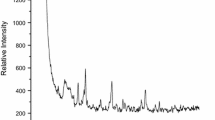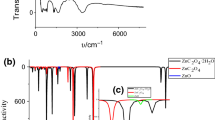Abstract
Differential thermal analysis (DTA) of some 25 oxalates are reported in atmospheres of oxygen and nitrogen. It is shown that in some cases in nitrogen the metal is formed, in other cases the oxide of lowest valency state is produced, while a third group give the same oxide product in nitrogen and oxygen. The production in oxygen of the oxide for the first group, and of a higher oxide in the second group is a phenomenon which in the first case involves a further reaction of the metal with the oxygen atmosphere. Another group of oxalates produce characteristic DTA curves due to the formation of carbonate as the initial decomposition product. The dehydrations of these oxalates are marked by endothermic peaks.
Résumé
On communique les résultats de l'étude de 25 oxalates par analyse thermique différentielle, dans l'oxygène et dans l'azote. On montre que pour certains d'entre eux, dans l'azote, le métal se forme, et que pour d'autres l'oxyde correspondant à la valence la plus faible apparaît; d'autres encore donnent le même oxyde dans l'azote et dans l'oxygène. Dans l'oxygène, et pour le premier groupe, il se forme l'oxyde, tandis que l'oxyde supérieur apparaît pour le second groupe; dans le premier cas, une réaction ultérieure du métal avec l'oxygène de l'atmosphère est mise en jeu. Un autre groupe d'oxalates donne des enregistrements d'ATD caractéristiques en raison de la formation de carbonate comme produit de décomposition initial. Ces oxalates se déshydratent en donnant des pics endothermiques.
Zusammenfassung
Es wurden 25 verschiedene Oxalate durch DTA in Stickstoff- und Sauerstoffatmosphäre untersucht. In einigen Fällen wurde in Stickstoff das Metall gebildet, in anderen das Oxyd von niedrigster Wertigkeit. Es kommt auch vor, daß das gleiche Produkt in beiden Gasen entsteht. Beide erwähnten Produkte werden in Sauerstoff entsprechend oxydiert. Bei einigen Oxalaten erhielt man charakteristische Spitzen, die zeigten, daß das erste Zersetzungsprodukt Karbonat war. Die Dehydration dieser Oxalate zeigte sich durch endothermische Spitzen.
Резюме
Проведен дифференци альный термический анализ (ДТА) 25 оксалатов в атмосфере кислорода и азота. Пок азано, что в некоторых случаях металл образуется в а зоте, в других случаях окис ь ниже окисленной фор мы, а третья группа дает одинаков ые продукты окисления в азоте и ки слороде. Образование в кислороде окисей, входящих в пер вую группу и образование высших окисей, входящ их в первую группу и образование высших окисей, входящих во вт орую группу, является феноменом, который в первом случ ае включает реакцию мет алла, проходящую с атм осферой кислорода. Другая гру ппа оксалатов дает харак терную кривую ДТА, соответствующую обр азованию карбоната, являющегося начальн ым продуктом распада. Процессы дегидратации этих ок салатов характери зуются энд отермическими пикам и.
Similar content being viewed by others
References
D.Dollimore, D. L.Griffiths and D.Nicholson, J. Chem. Soc., (1963) 2617.
Y. A. Ugai, Zhur. obshchei Khim., 24 (1954) 1315.
J. L. Doremieux andA. Boulle, C. R. Acad. Sci., Paris, 250 (1960) 3184.
D.Dollimore and D. L.Griffiths, “Thermal Analysis 65”, Ed. J. P. Redfern, Mac-Millan, 1965, p. 126.
D. Dollimore, J. Dollimore andP. D. Perry, J. Chem. Soc., (A) (1967) 448.
D. A.Young, Decomposition of Solids, Pergamon Press, 1966, Chapter 5, Exothermic Decompositions, p. 148.
W. E.Garner, Chemistry of the Solid State, Butterworths, 1955, Chapter 9, Kinetics of Exothermic Solid Reactions, p. 232.
D.Dollimore, J.Dollimore and J.Little, J. Chem. Soc., (1969) 2946.
D. Broadbent, D. Dollimore andJ. Dollimore, J. Chem. Soc., (A) (1966) 278.
D. A.Young, Decomposition of Solids, Pergamon Press, 1966, Chapter 3, p. 72.
B.Topley and M. L.Smith, J. Chem. Soc., (1935) 231.
T. B. Flanagan andC. H. Kim, J. Phys. Chem., 66 (1962) 926.
R. M.Dell and V. J.Wheeler, Reactivity of Solids (Ed. G.M. Schwab), (1965) 295.
D.Dollimore, J.Dollimore and D.Nicholson, J. Chem. Soc., (1965) 2132.
M. Volmer andG. Seydell, Z. Phys. Chem., 179 (1937) 153.
W. W. Wendlandt, Ann. Chem., 31 (1959) 408.
W. W. Wendlandt, T. D. George andG. R. Horton, J. Inorg. Nucl. Chem., 17 (1961) 273.
O. K. Srivastava andA. R. Vasudeva Murthy, J. Sci. Ind. Res. India, 21B (1962) 525–527.
D. Broadbent, D. Dollimore andJ. Dollimore, J. Chem. Soc., (A) (1967) 451.
P. K. Gallagher andC. R. Kurkjion, Inorg. Chem., 5 (1966) 214.
R. M. Haynes andD. A. Young, Discussions Faraday Soc. 31 (1961) 229.
J. Y. Macdonald andC. N. Hinshelwood J. Chem. Soc., 127 (1925) 2764.
Author information
Authors and Affiliations
Rights and permissions
About this article
Cite this article
Dollimore, D., Griffiths, D.L. Differential thermal analysis study of various oxalates in oxygen and nitrogen. Journal of Thermal Analysis 2, 229–250 (1970). https://doi.org/10.1007/BF01911405
Received:
Issue Date:
DOI: https://doi.org/10.1007/BF01911405




